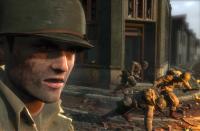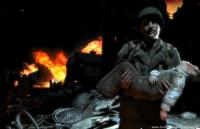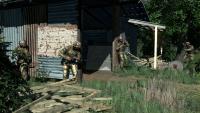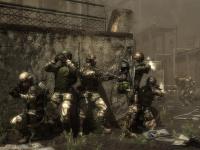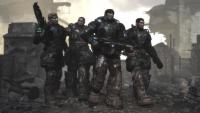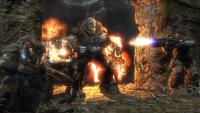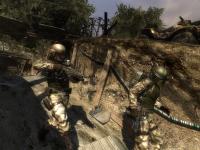Playing Soldier (in Hi-Def!)
Published by marco on
The Electronic Entertainment Expo—E3 for short—is taking place right now and is producing the expected wave of hype, “in-game” movies and “screenshots”. Check out the E3 insider or the IGN site for all the latest effusive marketing/reporting. Games that want to sell these days have to look good; to that end, publishers use high-quality screenshots and ridiculously good-looking in-game movies to draw in their audience. Recent years have seen an escalation in these types of tricks, with Sony releasing an “in-game” movie last year for hardware that doesn’t even exist yet. The movie was rendered on simulated hardware—most likely at an abysmal frame-rate—and sold as “what you will likely see in over a year’s time when the Playstation 3 finally comes out”.
Bullshot |bool’shät| – n. A screenshot fabricated by a company to misrepresent the graphics of a game; a combination of the words bullshit and screenshot.
What is a bullshot and what isn’t? What are the parameters for a believable screenshot? How fast was the game running when the shot was taken? On what kind of hardware? For whom are these detail levels recommended or even enabled? At what point do we stop calling them screenshots and start calling them movie stills? And finally, at what point is the level of detail so high that it’s a waste of processor power considering the pace of the game?
Hi-Def Humans
In the olden days, games used mip-mapping and level-of-detail (LOD) to ease the memory and rendering burdens, respectively, of a scene. Mip-mapping uses lower detail textures and LOD algorithms switches out high-polygon models for low-polygon ones for smaller, more distant objects. For all I know, this is still happening in game engines today, but, with a standard 128MB of video memory and lord knows how many pixel pipelines, texture units and sheer brawny transistor goodness available, the stakes are higher. In particular, the maximum level of detail is much higher, so objects seen from a short range have an incredible amount of detail. Take a look at the screenshots[1] from Brothers In Arms: Hell’s Highway below.
Each of the faces on these soldiers has more polygons than an entire character from any game made just a few years ago. The nearly photographic detail isn’t just in the closest soldier’s face, but in the clothes of the other soldiers behind him. Even the pieces of street rubble are unique and appear individually rendered. In the second scene, the soldier’s face is hidden in shadow he throws on himself, but his uniform actually looks like wool and look at the hands! Hands are never rendered with that amount of detail: this looks like Toy Story 2. Is it even conceivable that this is a game screenshot? Not on any hardware you’ll be owning anytime soon.
Geek Porn
This isn’t the first time screenshots have been released showcasing the Unreal 2007 engine[2]. The Hell’s Highway Movie #2 (FileShack) “shows the differences between the game’s previous engine and the new one.” It’s clear they’ve upped the ante on content considerably, but it’s such a tech-y video: the feature list reads like they’re trying to sell you the Unreal engine, not the game. Throughout the movie, the following callouts appear, to draw attention to a particularly cool rendering feature:
- High Definition; 16x Texture Resolution
- realistic, Non-Greasy Normal Mapped and Specular Lighting
- Real Time Self Shadows with Fuzzy Attenuation
- 16 Bit Color with High Dynamic Range
- High Fidelity Motion Capture “Anim Tree” Driven Animation
- Advanced Pixel Shaders with Subsurface Scattering
The focus here is so far away from what makes a game playable: it’s as if a salesman spent his entire sales pitch talking about the heated cupholders in the Porsche he’s trying to sell you. In a way, he can; you both know the car’s fast, but so are all other sports cars. They’re probably all good enough for you to cruise for chicks in—the deciding factor then becomes the small detail. For first person shooters, you know you’re going to be running around shooting shit with the same guns you’ve been shooting shit with for the last decade. But now you’re doing it with fuzzy attenuation and non-greasy normal maps. Woohoo!
Hi-Def Plants
No discussion of mind-blowing detail today is complete without mentioning the excellent work being done by Crytek with their CryEngine 2 and new game, Crysis[3]. The focus of the new engine and game is to render nature in all of its splendor, opening up a whole new vista of experience for gamers who haven’t left their parent’s basements in years. Though most prefer the dank, cramped hallways of Doom3, there are those who want to assuage an inner desire for the blue sky and green plants of nature. Crytek aims to fill this void:
A few years ago, publishers were spending a lot of money on server farms to render scenes like these for a few seconds of cinematics. Today, high-powered game engines deliver the same thing in real-time. The jungle shot, in particular, has a staggering amount of crisp detail provided by another litany of features: “Volumetric Clouds, Realtime Ambient Maps, Soft Shadows, Depth of Field [and] Motion Blur”. You can take a look for yourself in the Crysis GDC 2006 Movie (File Shack). The attention to detail is impressive, with plants reacting realistically to a soldier running through them and soldiers shooting them.
First Person Shooters Über Alles
It looks like a damned movie—but it’s still a movie of soldiers and tanks. This time they seem to be at war with nature as well as with each other. Though Crysis focuses on integrating full-blown nature, it still makes sure to dot the i’s and cross the t’s of the genre: guns? check. soldiers? check. Nice plants: brrrraaaaap!!!! mow ‘em down, they’re blocking the sight line to the enemy base.
How cool can we make soldiers look? Pretty cool as evidenced by the next set of screenshots:
Crysis shows off its integration of nature with the man-made (with painstakingly rendered hands, of course). Interestingly enough, both Quake Wars[4] and Gears of War[5] have about the same style of ensemble. A closer look shows a level of detail higher than even that of fancy comic book covers—with shadowing and highlighting that are taking games closer and closer to photorealism. But it’s all about soldiers and fighting and blowing shit up. And looking cool while doing it. Bestowing cool on the little (or grotesquely fat, depending on your mental image of a stereotypical gaming geek) dwellar in the cellar is what sells these games.
The soldiers are all male and beefed up (at least in Gears of War) and the games even make sure to put the word “War” in their title, just in case you were too thick to get the point. I’m not complaining—I play these games too. It would be cool, though, if these amazing real-time interactive near-video technologies could be used for something more uplifting than the glorification of war[6]. Look at these heroic poses from Gears of War:
Huge freakin’ arms with a little depth-of-field to put the focus on your grimly determined self. Or there you are, crouched behind a wall, muscular neck straining to draw a bead on the ugly alien.[7] Sure, this looks fantastic, but make sure you know what the pretty, pretty, pretty effects are selling you. Real-time lighting? Yup. Specular highlighting? Yup. Overbright? Yup. Wholesale slaughter of the other? Bought and sold.
A Difference in Style
The third shot above, Men in Sunlight is included to juxtapose, once again, Gears of War and Quake Wars. They may both feature soldiers, guns, the word “War” in their title, a story about repulsion of an alien attack and an emphasis on post-apocalyptic scenery, but they still look different. The art direction in Gears of War is distinctly more cartoonish than that in Quake Wars. This is not a judgement of the Unreal engine, but games made with the Doom engine just look more like photos of the real world than those made with the Unreal engine. Unreal games tend to have characters that look like they dropped out of a Japanese cartoon whereas those in Quake/Doom games tend to be proportioned like people from Earth. The two group shots above show this difference quite clearly as well.
So what’s to conclude from this long, rambling half–love-affair with awesome graphics and half–diatribe against the unrelenting focus on war in video games? The upcoming games look amazing; the emphasis on look leaves you wondering whether they’ll play about the same as everything else you’ve played, but this time with realistic squad behavior! If you want the games to look like the shots above when you play them, you probably need to invest heavily in your PC or just buy a damned X-Box 360[8].
